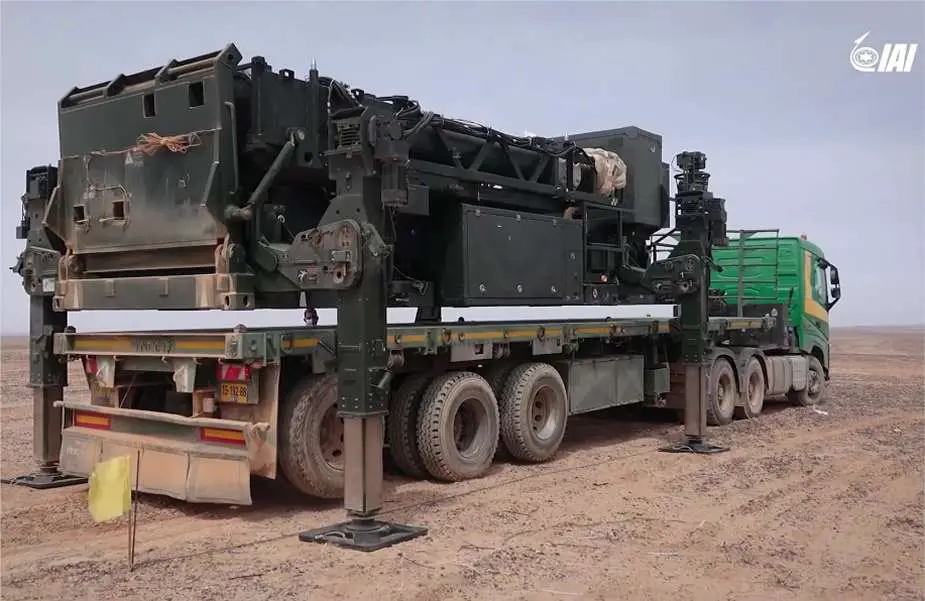Breaking news
Israel signs record $1.2 Bn deal with Azerbaijan for Barak MX air defense systems.
According to Defense Industry Europe on November 10, 2023, Azerbaijan finalized a defense agreement valued at $1.2 billion with Israel Aerospace Industries (IAI). If confirmed, this deal would represent the largest-ever sale of Barak MX air defense systems. This agreement follows a recent demonstration conducted by IAI in Azerbaijan, where various versions of the Barak MX air defense systems were showcased.
Follow Army Recognition on Google News at this link

The Transporter Erector Launcher (TEL), mounted on a semi-trailer chassis, features the ability to deploy eight missiles in under two minutes (Picture source: IAI)
Established in 1953, IAI initially focused on aircraft maintenance for the Israel Defense Forces (IDF). Over the years, it has evolved into a global aerospace and aviation company with approximately 15,000 employees. The company's operations span both military and civilian aerospace sectors, encompassing the production of diverse products, including aircraft, drones, fighter planes, missiles, avionics, and space systems.
IAI's role in the global air defense market is reflected in its diverse offerings, ranging from the Arrow 3 long-range air defense system and Arrow 2 short/medium-range anti-ballistic missile system to the Barak family of air defense systems and the Eagle Eye III very short air-defense system. This latest deal, ranking as the third-largest for an Israeli air defense system, follows other significant transactions, including the sale of the Arrow 3 system to Germany for $3.5 billion and the Barak 8 system to India for $1.8 billion.
The Barak MX air and missile defense system, developed by Israel Aerospace Industries (IAI), serves as an integrated defense system designed to offer protection against a variety of aerial threats. Known for its adaptability, the system is suitable for applications in both land and naval defense.
The system comprises various components, including the Barak Interceptors, such as the MR (Medium Range) with a 35 km range, LR (Long Range) with a 70 km range, and ER (Extended Range) reaching 150 km, specifically designed for theater ballistic missile (TBM) defense. Equipped with active RF seeker technology, it engages low radar cross-section and highly maneuverable targets effectively.
In terms of sensors, the Barak MX integrates with multiple IAI/ELTA land and naval AESA radars such as MMR, MF STAR, ALPHA, among others. The system's modularity facilitates seamless integration with sensors preferred by the customer.
The Battle Management Center (BMC) plays a crucial role in coordinating force operation networks, managing launcher batteries, and generating a unified multi-sensor aerial image. It is available in mobile, transportable, and stationary platforms.
The Transporter Erector Launcher (TEL), mounted on a semi-trailer chassis, features missile-launching containers with 360-degree launch capabilities. It can launch three types of missiles: Barak MRAD, LRAD, and ER, with the ability to deploy eight missiles. The launcher exhibits rapid response and short minimum ranges, capable of stopping and deploying in under two minutes.
Radar systems include Elta System’s ELM-2084, a 3D multi-beam AESA GaN-based radar system capable of identifying and monitoring both aircraft and ballistic targets. It provides fire control guidance for missile interception or artillery air defense and is available in various sizes and configurations.
In terms of operational capabilities, the Barak MX system boasts a range from 35 km to 150 km, with altitudes reaching up to 20 km for MR and LR missiles, and 30 km for ER missiles. The ER missiles showcase a maneuverability of up to 50 G.
Advanced features of the system include its modular design, allowing for cost-effective operational capability and adaptability to future threats. The system demonstrates an all-threat capability, effective against a range of targets, including aircraft, helicopters, gliding bombs, UAVs, cruise missiles, and TBMs. Automatic interceptor selection optimizes cost and operational effectiveness, and the network-centric configuration enhances joint operation and air defense redundancies. The Vertical Launch System (VLS) provides 360-degree coverage and quick reaction capability.
Regarding integration and adaptability, the Barak MX system can be seamlessly integrated with existing and new sensor systems. It exhibits flexibility in operation, capable of point defense and area defense missions, and is adaptable to joint task force coordination battle conditions. Designed for all-weather operation, it can operate in various environmental conditions, both day and night.


























